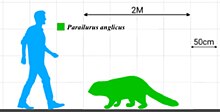Parailurus anglicus
| English panda Temporal range:
| |
|---|---|

| |
| Scientific classification | |
| Domain: | Eukaryota |
| Kingdom: | Animalia |
| Phylum: | Chordata |
| Class: | Mammalia |
| Order: | Carnivora |
| Family: | Ailuridae |
| Genus: | †Parailurus |
| Species: | †P. anglicus
|
| Binomial name | |
| †Parailurus anglicus Dawkins, 1888
| |
| Synonyms | |
| |
The English panda (Parailurus anglicus) is a one of three species of the extinct genus Parailurus. Parailurus anglicus was native to Europe, more specifically the British Isles, Slovakia, Romania, Germany, and Hungary.[1] Parailurus anglicus was twice the size of modern red pandas, and used to be classified in their genus Ailurus until 1899 following a study.
The species was first described in 1888. Its place in the evolutionary tree is debated, due to the family which it belongs in, Ailuridae. Modern genetic evidence suggests it belongs in Musteloidea, a clade which contains weasels, skunks, and raccoons.
Parailurus anglicus might have inhabited coniferous forests, similar to those that modern red pandas lived in.[2] Parailurus anglicus' teeth suggested that it was very likely omnivorous.[3]
Taxonomy
Parailurus anglicus was first described by William Boyd Dawkins in 1888, who originally called it Ailurus anglicus. The species was found at the Red Crag in East Anglia.[4] Max Schlosser reclassified the species' genus as Parailurus in 1899, following a study of the dentition of a more complete specimen from the Baróth-Köpecz locality.[5][2]
Tivadar Kormos described a new species of Parailurus called Parailurus hungaricus in 1939, this species is now a junior synonym for Parailurus anglicus.[6] Parailurus anglicus was the first species described in the genus Parailurus. The other two species, P. baikalicus and P. tedfordi, were described in 2008 and 2022 respectively.[7][6]
Phylogeny
The place of Parailurus anglicus, and Ailurids overall in the evolutionary tree has been debated. They were first placed in Procyonidae in the early 20th century for the raccoon's similarity with the red panda. Newer genetic studies in 2005, 2018 and 2021 have placed the Ailurid family in the clade Musteloidea, which includes Procyonidae, Mustelidae (weasels, mink and relatives) and Mephitidae (skunks and stink badgers).[8][9][10]
Description

Because the English panda has been only described by fragmentary remains, its appearance hasn't been well-documented. Other Ailurids provide the general idea of what the English panda looked like. Dawkins' specimen was a "battered and worn down" part of the right lower jaw, not giving much information of the appearance of English panda.[4]
A reconstruction by the Czech artist Oldřich Kroupa represented it as extremely similar to the red panda, though with darker and dull fur.[11] Parailurus anglicus was twice the size of a red panda,[1] and probably lived in a similar enviroment to that of the red panda.[2]
The English panda had a much rather distinct dentition when compared to other ailurids. It has a pretty unusual upper fourth premolar, with greater antoposterior length than transverse width.[12] Its teeth suggest it was an omnivorous animal.[3]
References
- ^ a b Rhys (2 March 2021). "Red Pandas And The Fossil Record Of Cuteness – The Bristol Dinosaur Project". The Bristol Dinosaur Project. University of Bristol. Retrieved 16 November 2024.
- ^ a b c Kurtén, Björn (1968). Pleistocene mammals of Europe. Transaction Publishers. p. 118.
- ^ a b Arment, Chad (2003). "The Lesser Pandas". ZooCreation. Darke County, Ohio. Retrieved 16 November 2024.
- ^ a b Dawkins, William Boyd (1 February 1888). "On Ailurus anglicus, a new Carnivore from the Red Crag". Journal of the Geological Society. 44 (1–4). Geological Society of London: 228–231.
- ^ Schlosser, Max. "Parailurus anglicus és Ursus Böckhi a baroth-köpeczi lignitből, Háromszék vármegyében". Magyar Állami Földtani Intézet évkönyve. 28. Franklin-Társulat Könyvnyomdája: 67.
- ^ a b Lawrence, Steven C.; Lyon, Lauren M. (5 November 2022). "Systematic revision of the Ailurinae (Mammalia: Carnivora: Ailuridae): with a new species from North America". Red Panda. Academic Press: 31–52 – via Elsevier Science Direct.
- ^ Sotnikova, Marina Vladimirovna (30 January 2008). "A new species of lesser panda Parailurus (Mammalia, Carnivora) from the Pliocene of Transbaikalia (Russia) and some aspects of ailurine phylogeny". Paleontological Journal. 42. MAIK Nauka/Interperiodica: 90–99.
- ^ Flynn, J. J.; Finarelli, J. A.; Zehr, S.; Hsu, J. & Nedbal, M. A. (2005). "Molecular phylogeny of the Carnivora (Mammalia): Assessing the impact of increased sampling on resolving enigmatic relationships". Systematic Biology. 54 (2): 317–337. doi:10.1080/10635150590923326. PMID 16012099.
- ^ Law, C. J.; Slater, G. J. & Mehta, R. S. (2018). "Lineage Diversity and Size Disparity in Musteloidea: Testing Patterns of Adaptive Radiation Using Molecular and Fossil-Based Methods". Systematic Biology. 67 (1): 127–144. doi:10.1093/sysbio/syx047. PMID 28472434.
- ^ Hassanin, A.; Veron, G.; Ropiquet, A.; van Vuuren, B. J.; Lécu, A.; Goodman, S. M.; Haider, J.; Nguyen, T. T. (2021). "Evolutionary history of Carnivora (Mammalia, Laurasiatheria) inferred from mitochondrial genomes". PLOS ONE. 16 (2): e0240770. Bibcode:2021PLoSO..1640770H. doi:10.1371/journal.pone.0240770. PMC 7886153. PMID 33591975.
- ^ Kroupa, Oldřich. "Parailurus". Biologus. Retrieved 16 November 2024.
- ^ Sasagawa, Ichiro; Takahashi, Keiichi; Sakumoto, Tatsuya; Nagamori, Hideaki; Hideo, Yabe; Kobayashi, Iwao (1 December 2003). "Discovery of the Extinct Red Panda Parailurus (Mammalia, Carnivora) in Japan". Journal of Vertebrate Paleontology. 23 (4). Taylor & Francis Group: 895–900.
